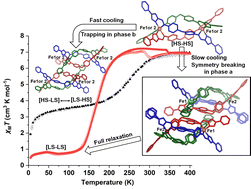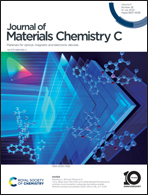Unique spin crossover pathways differentiated by scan rate in a new dinuclear Fe(ii) triple helicate: mechanistic deductions enabled by synchrotron radiation studies†
Abstract
The achievement of targeted properties in spin crossover (SCO) materials is complicated by often unpredictable cooperative interactions in the solid state. Herein, we report a dinuclear Fe(II) triple helicate 1, (single crystals (1·4(MeCN)5.75(H2O)Et2O), and air dried bulk samples 1·6H2O and desolvated 1), which represents a rare example of a SCO system possessing two distinct magnetic behaviours that depend upon the thermal scan rate. Desolvated 1 was seen to undergo spin transition (ST) which was complete following slow cooling (1 K min−1), but incomplete ST (corresponding to 50% conversion) on fast cooling (10 K min−1). The incomplete ST observed in the latter case was accompanied by a higher temperature onset of ST, differing from TIESST (Temperature-Induced Excited Spin-State Trapping) materials. The two SCO pathways have been shown to arise from the interconversion between two structural phases (a and b), with both phases having associated high spin (HS) and low spin (LS) states. SCXRD (Single Crystal X-ray Diffraction) experiments of 1·4(MeCN)5.75(H2O)Et2O using controlled cooling rates and a synchrotron light source enabled short collection times (2–3 minutes per dataset) which has enabled the identification of a mechanism by which the slow-cooled material may fully relax. In contrast, fast-cooled materials exhibit disordered arrangements of multiple structural phases, which has in turn revealed that the [HS–LS] ↔ [LS–HS] equilibria are controllable in the solid by varying the scan rate. Such behaviour has been previously observed in solution studies, but its control in solids has not been reported up to now. This study demonstrates how intermolecular cooperativity can allow multiple distinct magnetic behaviours, and provides some insight into how [HS–LS] ↔ [LS–HS] equilibria can be controlled in the solid state, which may assist in the design of next-generation logic and signalling devices.



 Please wait while we load your content...
Please wait while we load your content...